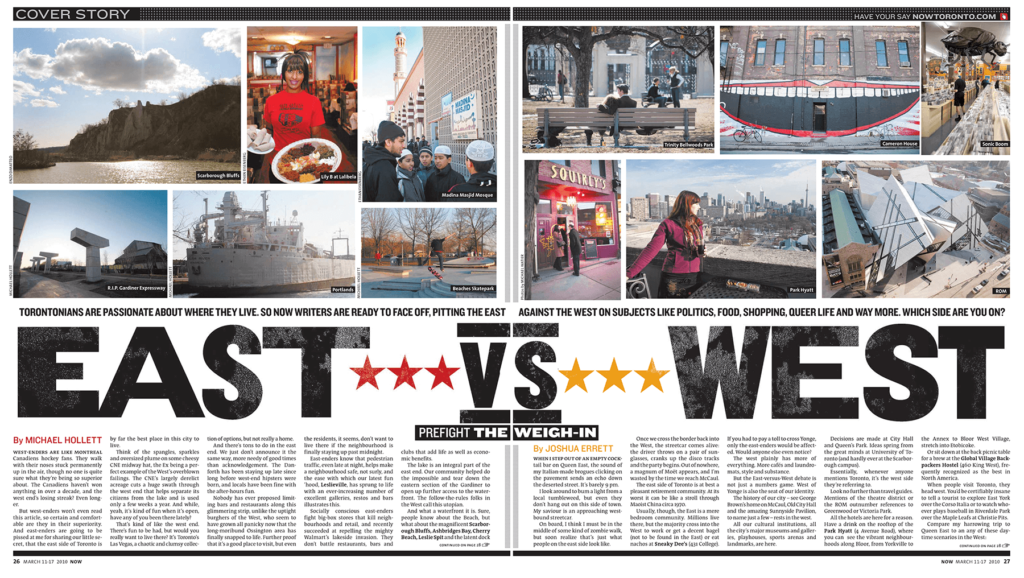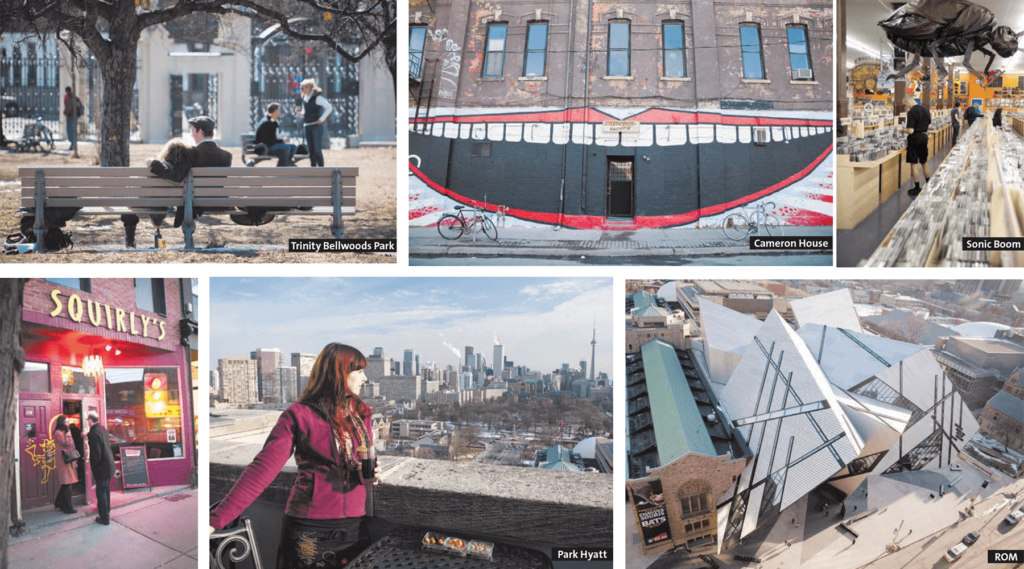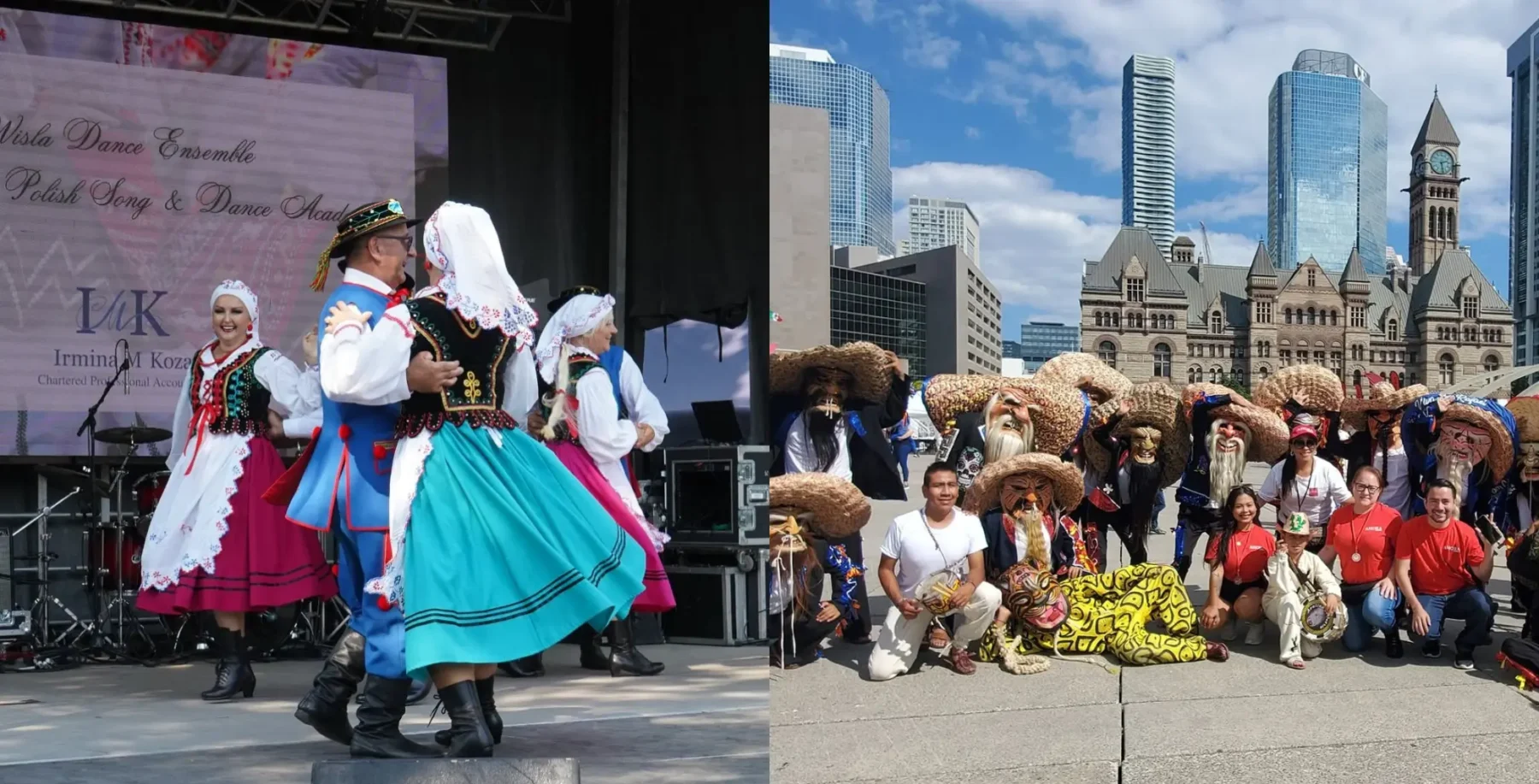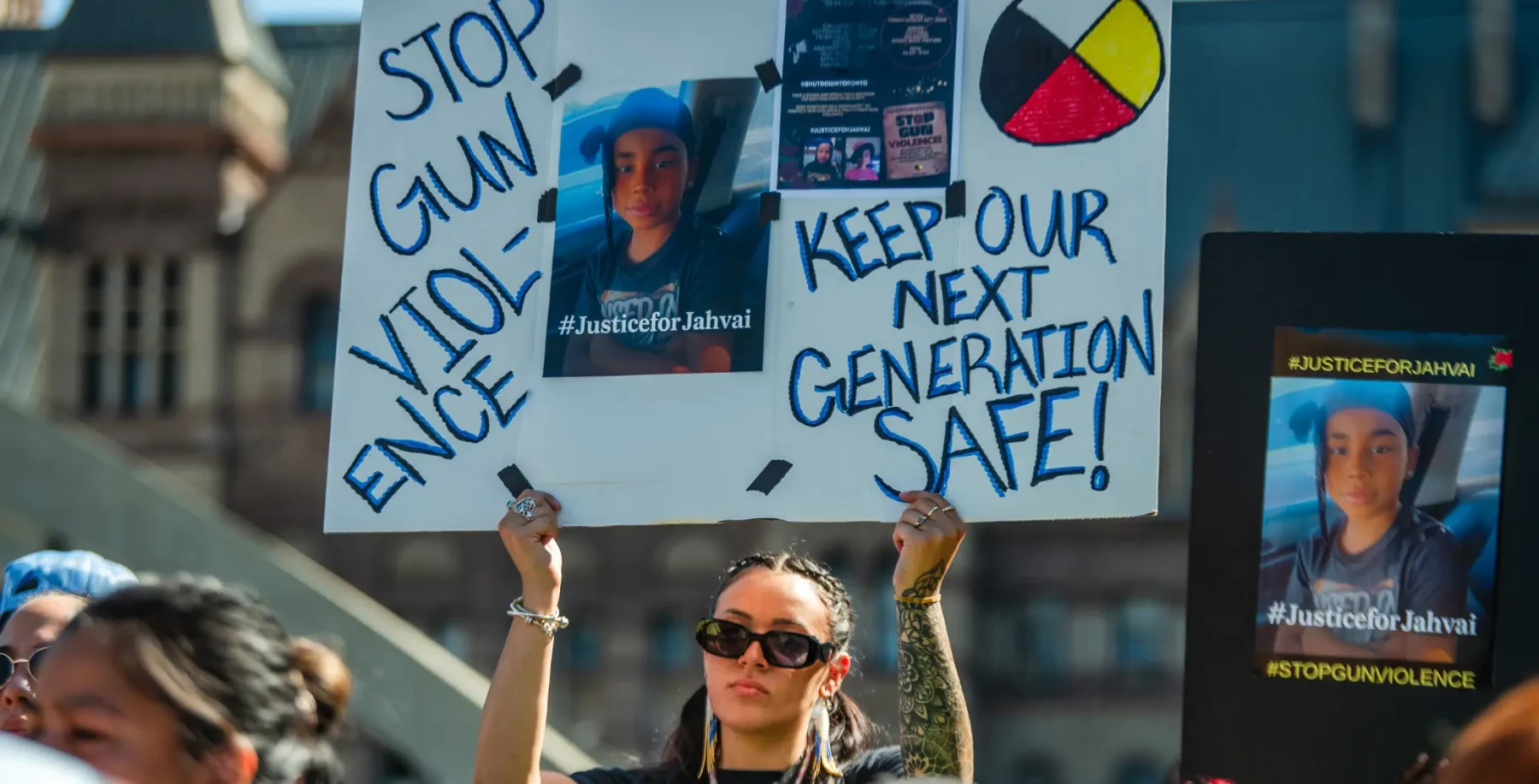
Eleven years ago, NOW Magazine devoted a cover story to the classic “east vs. west” divide in Toronto. Was it gimmicky? Toronto Life thought so – but they also thought it worthy enough to cover. But in a busy city where work schedules can keep us locked into the same travel patterns, people can get easily comfortable sticking to their own neighbourhoods.
Today, the pandemic has upended all aspects of life but of course our commodified housing market has gentrified areas that were considered affordable 11 years ago. Multi-storey Victorian rentals became Airbnbs and condos are springing up everywhere. Many arts venues have closed down. Galleries migrated away from Queen West. The differences between the east and west that formed the basis for NOW’s cover story – partying, dining, coffee, pubs, the queer scene, shopping, reinvented spaces – don’t seem that different. Everywhere is expensive – to rent or buy. But the pandemic has also forced people to stay local more than ever.
To reconsider the East vs. West debate, NOW’s editor Kevin Ritchie (a west ender) and culture editor Radheyan Simonpillai (an east ender) had a quick convo to exchange personal impressions of how each side of town has changed (or not) – before they both end up moving to Ajax.
RS: The East vs. West article came out a year after I bought a house in Leslieville. The main reason I bought in Leslieville was because at the time it was considered an up-and-coming neighbourhood where the investment would pay out. Also, being from Scarborough, it was a happy compromise. I was close to where I worked in the city, but could easily access my family. I remember those east vs. west conversations happening. I had a lot of friends renting in the west end or who lived downtown in a condo and they were all trying to buy in the Junction or the Annex. The idea of moving to the east end was horrifying to them because their whole social life was on the west end. And I think you get a sense from these articles that everyone’s social life is on Queen or King West. There’s a certain stage of life that the west end appeals to. But then those people ended up moving east when they needed an actual house.
KR: When this article was published, I was renting in a house in Little Portugal where I lived for 10 years. You could see the dramatic change on Queen West, especially near the Gladstone Hotel and the Drake Hotel. The art galleries are mostly gone, replaced by retail and chain drug stores and banks. That strip became a destination neighbourhood whereas Dundas West still had a local feel. There used to be a more visible gay scene in the west that’s completely gone now at least in terms of dedicated venues. The pandemic accelerated that when the Beaver closed. People had to become more resourceful. There were more underground dance parties happening north around Bloor or further west toward Keele, but in the east you also had Cherry Beach and the odd industrial space where someone would throw a party. As Trinity Bellwoods and Little Portugal became expensive, a lot of west-end renters I know moved even further west, from High Park to Bloordale and north to St. Clair West.
RS: The expression that I think everyone latched on to from Michael’s article on the east end was “divine neglect,” where he suggests the east end benefited from the disinterest of condo developers. Consider our cover story on Scarborough – Suresh Doss talks about the beauty of Scarborough being all these ethnic hubs that were created because of the neglect; because the TTC was such a terrible system that left neighborhoods disconnected. It’s interesting how that divide or neglect works there. But I think rather than east vs. west, the comparisons now will be more about the city with areas further north because that’s where people are moving now.
KR: The north-south dynamic has happened within the west end. In terms of the west’s rep as a social destination, Ossington was the place to party, and then it became more about upscale dining. For a while Geary Avenue was the hot place to party but the parties can’t happen anymore. It’s become more developed and the neighbours were calling the police on after hours events. You see these bursts of activity in specific areas and then gentrification happens. Although during the pandemic there were outdoor parties in parks in both the east and the west last summer. It felt like there was a lot of movement between the two sides – at least among people who felt safe going to outdoor dance parties.
RS: Do you still hear about this east versus west debate today? You’re a west ender. One thing they talked about in the articles was how the west enders didn’t even give a shit about the east and didn’t know it existed.
KR: I still think that’s true! [laughts] To an extent anyway – I think it’s more common now for people I know to go east, especially given the gay scene has shifted back to the east. Though the pandemic and development is threatening spaces in the east, with the Old Nick and Club 120 closing. But I think people will be itching to get out of their neighbourhoods as life starts to resume. I’m now following all these bars and restaurants on Instagram that pivoted to doing takeout and many are in the east end and out of my delivery range. In general, I think being in this geographic stasis has given people a greater appreciation for exploring the city. Local travel will be the main option until international travel scales back up.
RS: And obviously this is a conversation that only exists for the privileged people who could live close to the city. My friends in Scarborough consider where I live downtown. I don’t live in the east end according to them.
KR: What about the east-west dynamic in terms of political activism and protest? That’s another area the cover story touched on. There are a lot of rental apartments in the west and northwest so it’s become a focal point for tenant organizing and housing activism. As we’re having this conversation, there’s a solidarity BBQ for people living in encampments in Trinity Bellwoods Park, though the encampment in Moss Park has been a big focal point for activism around homelessness during COVID as well. Last summer, the Take Back The Night March happened in the west end, and some of the Black Lives Matter protests started in Christie Pits before they headed downtown to police headquarters.
RS: I think that speaks to Michael’s point in his article that the east goes to the west end for that stuff and then go back home. I never hear about tenants speaking out in Scarborough but it could be the headlines I’m reading. Or it could be that the big private equity firms that tenants organize around are buying up properties in the west end because it’s considered a more attractive neighbourhood. Even in Rexdale, it’s somewhat closer to the subway line and transit than areas in the east end of Scarborough.
KR: I took a look at Weedmaps and BottleShopsTO map and the west also appears to be more awash in weed and booze retailers compared with the east.
RS: The west end has always trended younger, more single, more social life. Going back to the cover story, Michael argued that there wasn’t as much NIMBYism in the east as the west end.
KR: Well the obvious thing is that if there isn’t as much partying happening, there’s not going to be as much NIMBYism directed at partying.
RS: Do you remember when AfroFest moved to Woodbine Park and got in trouble for noise violations? There’s definitely NIMBYism in the Beaches. You just need to look at all the Facebook groups. You see more acceptance in Leslieville or Riverdale groups than you do in the Beach groups.
KR: Not that there are any dedicated dance clubs to complain about anymore. You can probably count the ones left in the west end on one hand – assuming they survive the pandemic. In the east, there was the uproar over the Crews and Tangos development and all the east end nightclubs mentioned in the NOW cover story, like Fly, are long gone. You still have the big music venues in the east like Opera House, Danforth Music Hall and the Phoenix holding out. The jazz venues are still holding on in the east and west though the first live music to come back last summer was the Senator balcony series – gotta give the east credit for that one.
RS: Today, the east vs. west argument is maybe more about the rental market since it’s not really an issue for the home ownership market. If you’re looking for something under a million dollars in Toronto, you’re not finding it east or west.
Below is Michael Hollett and Joshua Errett’s cover story, East vs. West, republished from NOW’s March 10, 2010 issue:

East vs. West: The weigh-in
By Michael Hollett
West-enders are like Montreal Canadiens hockey fans. They walk with their noses stuck permanently up in the air, though no one is quite sure what they’re being so superior about. The Canadiens haven’t won anything in over a decade, and the west end’s losing streak? Even longer.
But west-enders won’t even read this article, so certain and comfortable are they in their superiority. And east-enders are going to be pissed at me for sharing our little secret, that the east side of Toronto is by far the best place in this city to live.
Think of the spangles, sparkles and oversized plume on some cheesy CNE midway hat, the Ex being a perfect example of the West’s overblown failings. The CNE’s largely derelict acreage cuts a huge swath through the west end that helps separate its citizens from the lake and is used only a few weeks a year. And while, yeah, it’s kind of fun when it’s open, have any of you been there lately?
That’s kind of like the west end. There’s fun to be had, but would you really want to live there? It’s Toronto’s Las Vegas, a chaotic and clumsy collection of options, but not really a home.
And there’s tons to do in the east end. We just don’t announce it the same way, more needy of good times than acknowledgement. The Danforth has been staying up late since long before west-end hipsters were born, and locals have been fine with the after-hours fun.
Nobody has ever proposed limiting bars and restaurants along this glimmering strip, unlike the uptight burghers of the West, who seem to have grown all panicky now that the long-moribund Ossington area has finally snapped to life. Further proof that it’s a good place to visit, but even the residents, it seems, don’t want to live there if the neighbourhood is finally staying up past midnight.
East-enders know that pedestrian traffic, even late at night, helps make a neighbourhood safe, not surly, and the ease with which our latest fun ‘hood, Leslieville, has sprung to life with an ever-increasing number of excellent galleries, restos and bars illustrates this.
Socially conscious east-enders fight big-box stores that kill neighbourhoods and retail, and recently succeeded at repelling the mighty Walmart’s lakeside invasion. They don’t battle restaurants, bars and clubs that add life as well as economic benefits.
The lake is an integral part of the east end. Our community helped do the impossible and tear down the eastern section of the Gardiner to open up further access to the waterfront. The follow-the-rules folks in the West call this utopian.
And what a waterfront it is. Sure, people know about the Beach, but what about the magnificent Scarborough Bluffs, Ashbridges Bay, Cherry Beach, Leslie Spit and the latent dock lands? Impressive oversized freighters still slide into the slips of the eastern waterfront, a reminder of the time when industry was actually an employer in this city.
The west end’s been a hot spot so long that all kinds of development crimes have been inflicted on it. Going back to the early 1900s, when a developer-friendly arsonist burned down the art deco Palace Pier, the son of Sunnyside, so money men could get on with building “the new,” the West’s problem has been that everyone wants a piece of it. (How fitting that the Palace Pier name lives on only as a condo.)
The once elegant streets of Parkdale used to go all the way to the water, but progress dictated that a highway had to tear through this neighbourhood. And a mad dash to develop has created a wall of lakeside condominiums that may as well as serve as tombstones for neighbourhood building in the West.
East Toronto has been the beneficiary of divine neglect, like an elegant eastern European capital, saved from the ravages of late 20th-century capitalism by stuttering socialism, free to be kick-started as more humane, green and inspired ideas of urban planning now rule.
So when the crumbling Greenwood racetrack was torn down, a real community rose from the rubble, with a mixed bag of rental and owner-occupied homes along with a naturalized park and half-pipes for skateboarders. Look for a similar community to emerge at Regent Park and the newly naturalized Don River Lands.
Divine neglect? Just check out the Distillery District and the exciting Brick Works to see what happens when redevelopment is stalled until more enlightened 21st-century thinking saves the day. The East’s industrial sites were abandoned, not bulldozed, so they were preserved when creative reuse came back into fashion.
Long before the Brick Works rebuilding, the Don Valley was an east-side green gem, so egalitarian that the rich of Rosedale share this unlikely urban nature preserve with the working-class East Yorkers on the other side of the valley.
In a city that celebrates diversity, the East has plenty. Established Greek, East Indian and Chinese enclaves now welcome the latest immigrants drawn by the area’s cheap rents. An the emerging African neighbourhood growing on the Danforth from Greenwood to Woodbine is the world’s latest gift to T.O.
And there’s plenty of reason to be hopeful for the future in the East, where Riverdale offers a textbook example of tolerable gentrification. The established Greek community didn’t move out, just made some room when the yuppies came along. Community involvement, from park programs to schools and political action, remains intense, and the People’s Republic of Riverdale has been voting left wing uninterrupted since John Sewell repped the area in the 70s.
So the smugsters of the West are welcome to enjoy their soulless side of Yonge while we on the East carry on reinventing scintillating city life.

By Joshua Errett
When I step out of an empty cocktail bar on Queen East, the sound of my Italian-made brogues clicking on the pavement sends an echo down the deserted street. It’s barely 9 pm.
I look around to bum a light from a local tumbleweed, but even they don’t hang out on this side of town. My saviour is an approaching westbound streetcar.
On board, I think I must be in the middle of some kind of zombie walk, but soon realize that’s just what people on the east side look like.
Once we cross the border back into the West, the streetcar comes alive: the driver throws on a pair of sunglasses, cranks up the disco tracks and the party begins. Out of nowhere, a magnum of Moët appears, and I’m wasted by the time we reach McCaul.
The east side of Toronto is at best a pleasant retirement community. At its worst it can be like a stroll through Maoist China circa 1970.
Usually, though, the East is a mere bedroom community. Millions live there, but the majority cross into the West to work or get a decent bagel (not to be found in the East) or eat nachos at Sneaky Dee’s (431 College). If you had to pay a toll to cross Yonge, only the east-enders would be affected. Would anyone else even notice?
The west plainly has more of everything. More cafés and laundromats, style and substance.
But the East-versus-West debate is not just a numbers game. West of Yonge is also the seat of our identity.
The history of our city – see George Brown’s home on McCaul, Old City Hall and the amazing Sunnyside Pavilion, to name just a few – rests in the west.
All our cultural institutions, all the city’s major museums and galleries, playhouses, sports arenas and landmarks, are here.
Decisions are made at City Hall and Queen’s Park. Ideas spring from the great minds at University of Toronto (and hardly ever at the Scarborough campus).
Essentially, whenever anyone mentions Toronto, it’s the west side they’re referring to.
Look no further than travel guides. Mentions of the theatre district or the ROM outnumber references to Greenwood or Victoria Park.
All the hotels are here for a reason. Have a drink on the rooftop of the Park Hyatt (4 Avenue Road), where you can see the vibrant neighbourhoods along Bloor, from Yorkville to the Annex to Bloor West Village, stretch into Etobicoke.
Or sit down at the back picnic table for a brew at the Global Village Backpackers Hostel (460 King West), frequently recognized as the best in North America.
When people visit Toronto, they head west. You’d be certifiably insane to tell a tourist to explore East York over the Corso Italia or to watch whoever plays baseball in Riverdale Park over the Maple Leafs at Christie Pits.
Compare my harrowing trip to Queen East to an any of these daytime scenarios in the West:
- Begin with the famed doughnuts at the Hoof Café (923 Dundas West), where restaurant trends are set. Then walk south for a flavourful yerba maté at El Almacen (1078 Queen West). Then hang in Trinity Bellwoods Park, ground zero for Toronto’s hipster population, where you’re likely to see the young and fashionable playing badminton in bikinis. Follow that with a crisp pint at Squirly’s (807 Queen West) and a casual browse through the vinyl collection at Cosmos (663 Queen West).
- Take it up north a little to the Annex. Slip into the Bloor Cinema (506 Bloor West) with a flask of sangria to catch a forgotten classic, followed by tasty Salvadoran fare at Tacos El Asador (690 Bloor West). Swing back by the Tranzac Club (292 Brunswick), the idiosyncratic venue that hosts Australians and left-of-centre music.
- Up on the burgeoning stretch of Dupont between Spadina and Davenport it’s a whole new adventure. Grab a chunk of La Sauvagine at Nancy’s Cheese (260 Dupont) en route to the impressive city views at Casa Loma (1 Austin Terrace) and the Spadina Museum (285 Spadina Road). Afterwards, go for a nosh at amazing nighttime wine bar Ezra’s Pound (238 Dupont).
Walking along Dupont, you’ll note an orphaned sign for what must have been a terrific bar, Nightcaps by the Castle. It’s more proof that the West has always been cool.
Obviously, that strong nightlife flavour lives on. The infamous strip on Ossington between Dundas and Queen, and Queen by the Drake Hotel, Gladstone and Wrongbar is a bustling marketplace for late-night carousing, impressive live music and, in general, attractive drunk flesh.
There are millions of these kinds of escapades to be had in the West, which is filled with vibrant, mixed-use neighbourhoods and awe-inspiring architecture.
But the most fundamental factor is that the West is inviting.
Above and beyond tourism, it has almost single-handedly welcomed Toronto’s numerous waves of immigration over the years. Kensington Market is a national beacon of multiculturalism, from Italian to Caribbean to Chinese to eastern European. The west end will always be a destination for new arrivals.
This, along with the influx of new students every September, allows the West to renew itself regularly.
Neighbourhoods reinvent themselves here. West Queen West, for instance, might now be more of a gay village than the officially anointed gay village on Church. In five years, it might be a hangout for Russian Jews or followers of the Aga Khan.
It’s a wonderfully breakneck pace.
The East lacks that ability to reinvent itself. It is staid, which ultimately spells boring. Greektown along the Danforth is a prime example it hasn’t changed in nearly 40 years, and probably never will.
That’s probably why the planners made sure the ROM, Yorkville, BMO Field and all the other points of interest in between stayed west.
That’s why they T-boned the East with the DVP, while sparing the West by stopping the Allen at Eglinton.
And that’s why whenever I go anywhere, it’s within the boundaries of my beloved West.
Check back every Monday for a new 40 at 40 cover story marking NOW’s 40th anniversary year.












